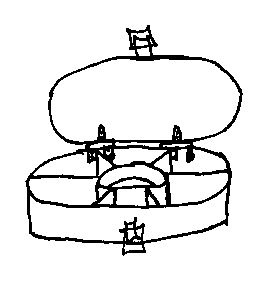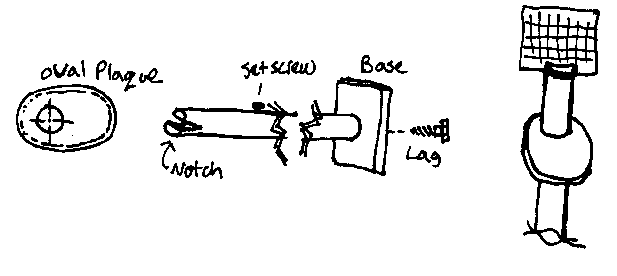Altars, Boxes and Glyph Kits
Bomos and glyph kits
Our bomos began life as a fairly simple trunk, (a footlocker, we think). As the plans for the Bomos require that it be in the form of a double-cube, we needed to bring the trunk up to snuff. We did this by the fairly simple stage-crafting device of forming a plywood top of the required dimension, then adding a bit of height to the trunk until it at least skeletally represented the form of the double-cube. We next formed a black drape such that it resembled the form of the double cube by stitching a square panel (the size of the plywood top) to four more panels of the correct length and width for the sides. The result is quite portable and tremendously unassuming in appearance--a desirable trait.. The diagrams below should present this idea clearly enough.

The above was accomplished with tools no more complicated than a drill, but if one has a table saw at one's disposal, it is a simple matter to build a giant, double-cube "pillbox" sort of affair, the top of which slides down neatly onto the bottom portion. In any event, the inside must remain open for storage of ceremonial items and the plywood top. Ours holds all but the sword, which is a fraction too long for any dimension of the case. If we had it to do over (likely) we'd address that very issue.
As for the Glyph Kit, a number of things may do, ranging from a cubic file box to a multi-compartmented box such as that shown in the sketch below. It must be sized to accomodate the sorts of items one can expect to keep in it, i.e. planetary-specific batteries and things to batter them with, incense, token offerings, things collected from the site, herbs, metal, stones, etc.

Lesser Glyphs
This can be anything from quite simple to tremendously difficult, as you wish. Our method was simple and cost only a few dollars: we bought seven appropriate colors of Sculpey modeling compound, then blended them together quite well until a uniform (and somewhat drab) color was obtained. We next rolled it out bewteen two sheets of waxed paper with a rolling pin (a smooth bottle will do) until it was of uniform thickness, about 1/4". Next, we trimmed the edges off with a knife such that a near-perfect hexagon was formed which we then "tattooed" with a largish needle. Once the design elements were all in place, we baked it in the oven for the specified period of time. A metal file was used to clean up and square the edges prior to painting.
If one has access to the appropriate tools and skills, a number of possibilities present themselves ranging from a drilled-and-coped sheet of gold or brass to a wooden puzzle-box. We imagine that a number of possible objets d'art might be made to fit the bill quite nicely, for it needn't have the exact form of your Glyph. Imagine an astrolabe, a six-sided lamp or even a small sculpture.
Bookstands
And why bookstands? We are of the habit of not wishing to put a book or other reference materials upon our bomos, as that ought to be reserved for things more directly pertinent to our work at hand. Nor can we expect to memorize every rite we are likely to perform, as we are evolving new forms all the time, as would anyone engaged in such a project as ours. The simplest and possibly best way of solving this problem is with an ordinary, flat black, utilitarian-looking music stand available wherever band instruments are rented and sold. They are often less than $20.
From there, it's no mean feat to dress the thing up to the point where it will be a respectable part of one's "decor". We envision an ornately-carved leg with one end pointed, the other flat. The pointed end may be stuck into the gound (if outdoors) or may be fitted to a stand (if indoors). The flat end is drilled out about an inch or so deep in order to receive the connecting portions of the score-holder. With luck and planning, such a thing should easily fit into the bomos.
If a more permanent fixture is desired, consider window shopping at a Christian supply store for a bible-stand, of at an office supply outlet. At the very least, one can get a good idea of what can be accomplished with this old-world relic. In every case, however, we recommend that the bookstand's height be no higher than the top edge of the bomos for reason which are both symbolic and practical. It should not be so low as to fall out of reach of any illumination.
Lampstands
These are a different matter and allow for a much broader interpretation of the furnishing. One can probably expect to need seven lampstands total, each being of the same appearance and dimension. A down and dirty method is described here:
First, obtain seven, 4' closet-type rods or dowels of similar size, seven small metal bowls and seven plaques of wood about 6-8" across and at least 3/4" thick. Drill a hole in the centers of the dowels to a depth of about 1" with a bit that is slightly smaller in diameter than the lag screws or wood screws you're going to use. Next, dill and countersink a hole in the middle of the plaques, assemble the dowels to the plaques by means of a screw passing up through the plaque to be received by the hole drilled in the end of the dowel. The attachment of the metal bowl is accomplished in much the same fashion, but light hardware is required and the hole need not be countersunk.
There is a variation on this plan that is well worth mentioning. If one proceeds with the first steps but leaves off the metal bowl, one can create an insert for an Enochian tablet (or something similar) by sawing out a wide and tapering notch across the end of the dowel. To provide additional illumination to this tablet or other item, a slip-shelf is fashioned such that it can slip over the dowel to a certain point below the end and support a lamp. The simplest way to create such a shelf is to find an oval plaque and drill a hole in it at about the one-third-way point across it's face such that the dowel can pass through it easily, if snugly. Simple friction and a setscrew fixed into the dowel at the desired point will be sufficient to support the weight your lamp.

This page is part of The Companions of the Glyph Website